No Cuts, No Stitches, How Neuro-Intervention Treats Brain Conditions Without Open Surgery
By – Dr Sumit Goyal, Director, Neurosurgery and Group Director Neurointervention, Yatharth Hospital, Greater Noida
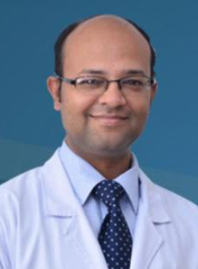
For a long time, brain problems like stroke or aneurysm could only be treated through open surgery, which meant cutting open the skull, long recovery, and visible scars. But now, a new approach called neuro-intervention allows doctors to treat many serious brain conditions without making a single cut on the head.
The result is a safer, quicker, and less painful recovery. In India, over 18 lakh people suffer a stroke every year, and the demand for faster, less invasive brain treatment is rapidly growing across both urban and rural areas.
Understanding the Procedure
Neuro-intervention is a method where doctors treat brain conditions using a very thin tube, inserted through a small hole in the leg or wrist. With the help of live X-ray images, the tube is guided through blood vessels all the way to the brain. Once it reaches the affected area, the doctor can remove a blockage, seal a weak blood vessel, or stop abnormal bleeding.
The entire treatment is done from outside the brain, with no cuts or stitches on the head. In most cases, the patient remains awake or under light sedation. However, certain procedures or emergency situations may require general anaesthesia for safety and comfort. Most patients are able to go home in just a day or two. There is no large wound, and recovery is much faster compared to traditional brain surgery.
Common Conditions Treated Without Surgery
One of the main uses of neuro-intervention is stroke treatment. In strokes caused by a blood clot, doctors can use a special device through the tube to pull the clot out and restore blood flow to the brain. This can help prevent long-term disability and even save lives, if done in time.
Another common condition is brain aneurysm, which is a balloon-like bulge in the arteries that can burst and cause dangerous bleeding. Doctors can now treat them by placing coils or flow diverters through catheters to seal them off safely from the inside
Neuro-intervention can also be used for carotid artery stenting, a procedure that treats narrowed neck arteries supplying blood to the brain. By placing a stent through a minimally invasive route, doctors can restore blood flow and lower the risk of stroke without requiring open surgery.
Faster Recovery and Why Timing Matters
Because this method doesn’t involve cutting the head, patients feel less pain, recover faster, and have fewer risks of infection or complications. Many are able to walk the same day, and the hospital stay is much shorter. Some may need physiotherapy or speech therapy afterward, especially in stroke cases, but overall, recovery is quicker and smoother.
In emergencies like stroke, every minute matters. If treatment is delayed, parts of the brain can get permanently damaged. That’s why it’s important to recognize warning signs like sudden weakness in the body, slurred speech, or a drooping face, and rush to a hospital immediately. The earlier the treatment, the better the chances of full recovery.
A New Hope in Brain Care
Neuro-intervention is changing how we treat brain conditions. More hospitals in India are adopting this technology, giving patients better and safer options. Whether it is stroke, aneurysm, or other brain vessel problems, many can now be treated without the fear of brain surgery.
The goal of modern brain care is not just to treat effectively, but to do it in a way that is easier on the patient. Thanks to neuro-intervention, we can now treat the brain without cutting into it, giving patients a faster return to normal life, and a future full of possibilities.
Surgery Restores Homemaker’s Life from Rare Jaw Infection
From Social Isolation to Confidence: Surgery Restores Life of a Homemaker with Rare Jaw Infection
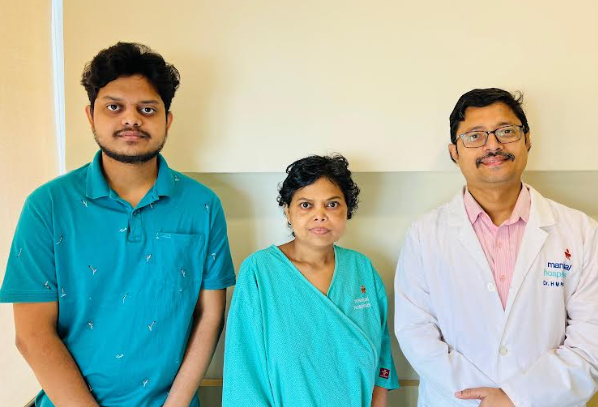
Bhubaneswar, 11th July 2025: In her 50s, Ms. Geeta Rani , was leading a vibrant, healthy, and happy life. Hailing from Bhubaneswar, she spent most of her life fulfilling her role as a homemaker and caring for her family. However, life took an unexpected turn when her health ordeal started to disrupt the peace of her life, with a COVID-19 diagnosis, followed by Mucormycosis (black fungus infection), for which she had to undergo surgery. Just when it all seemed to be in the past, Ms. Geeta started having another health problem – a persistent pus discharge from her upper jaw, accompanied by severe bad breath, pain, and weakness.
Her condition deteriorated to the point where she could no longer manage her daily chores and was isolated completely. Even friends and close relatives avoided contact and stopped visiting her condition. The family, without wasting time, visited Manipal Hospital Bhubaneswar and consulted with Dr. Harsh Mohan Pathak, Consultant – Dental Medicine and Maxillo-Facial Surgery, who was quick to identify the problem. On evaluation, it was revealed that the upper jawbone (left maxilla) had been completely destroyed by chronic infection, with pus draining from the maxilla and maxillary sinus. She also developed haemolytic anaemia, a condition where the body mistakenly attacks its own red blood cells, causing premature death of RBCs (red blood cells) and leading to critically low haemoglobin levels. This made her condition even more critical and challenging for doctors to carry out a decisive plan, which was the need of the hour.
Despite the complexity, Dr. Pathak and his team devised a precise surgical plan. A complete left-sided maxillectomy, followed by debridement, was performed to remove the diseased jawbone and clear the infection. The surgery was especially high-risk, and meticulous care was taken at every step. To restore both function and appearance, a buccal (cheek) issue was used to reconstruct and cover the surgical area and promote healing.
Dr. Harsh Mohan Pathak noted, “This case was exceptionally rare and challenging, as we had to consider multiple systemic challenges, including hemolytic anaemia and post-mucormycosis complications. However, with careful planning and surgical precision, we were able to restore her function and quality of life.”
Postoperatively, Ms. Geeta had an uneventful recovery. Not only did her chronic infection resolve, but she could also speak and enjoy her meals normally, participating in family gatherings without discomfort. Her transformation was so profound that she described it as having “the monster removed from the jaw”.
Tata Trusts Pushes Early Cervical Cancer Screening
Bengaluru, 10th July 2025: Sometimes, one of the hardest battles a woman fights is the one with herself – the doubt, silence, and hesitation to put herself first. Tata Trusts’ public health awareness campaign, ‘Khud Se Jeet,’ captures this quiet conflict, urging women to seek timely cervical cancer screening and take charge of their health.
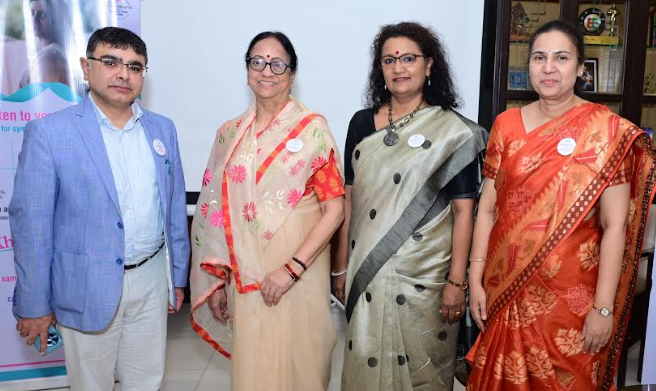
Cervical cancer is the second most common cancer among Indian women, claiming nearly 75,000 lives each year—often due to late detection. Despite being highly treatable in its early stages, with 95% of cases successfully managed if caught early, many women do not get screened in time. Millions of women continue overlooking symptoms – either due to a significant lack of awareness about cervical cancer and its symptoms, or fear, stigma, and a culture of silence that contributes to delayed screening.
Tata Trusts’ years of grassroots engagement – including by conducting over 26,000 cervical cancer screenings across Jharkhand, Andhra Pradesh, Odisha, and Maharashtra in the last year, in collaboration with state governments and partners – has uncovered deep insights, revealing emotional and societal barriers that keep women from seeking help, even when it’s available. Through its public health awareness initiatives, the Trusts aims to prompt women to replace hesitation with action.
To spearhead awareness, Tata Trusts hosted a panel discussion, bringing together leading experts from oncology, psycho-oncology, and patient support to illustrate the problem, barriers to screening, key steps, and explore how we can change the conversation on cervical cancer in India. The session featured Dr Gauravi Mishra, Deputy Director, Center for Cancer Epidemiology, Tata Memorial Centre; Dr. Savita Goswami, Psycho-Oncologist at Tata Memorial Hospital; and Vandana Gupta, cancer survivor and founder of V Care Foundation.
The session was moderated by Dr Rudradatta Shrotriya, Head Medical Operations, Tata Cancer Care Foundation, who commented, “Cervical cancer’s projected burden in India stands at 1.5 million Disability-Adjusted Life Years (DALYs), with the highest impact among women aged 30–65 in segments with the lowest awareness and access. The key challenges remain low awareness and inhibition: women who experience early symptoms do not connect them to cervical cancer, and those who do may delay action due to shame or fear. Many also are unaware that risk can exist even in the absence of symptoms, which makes screening vital. By raising awareness and taking steps to change the conversation around cervical cancer, we hope to foster a culture where women feel empowered to prioritize their health.”
Tata Trusts also unveiled a social awareness film, highlighting a woman’s inner conflict and journey through self-doubt, denial, and hesitation to a moment of transformation, where she chooses to pay attention to her symptoms and seek screening. By amplifying such narratives, the Trusts’ aim to inspire more women to listen to their bodies and prioritize their health.
Discussing this, Shilpi Ghosh, Communications Specialist, Tata Trusts, said, “Khud Se Jeet was born from listening to women — their silence, their fears, their hesitation. Cervical cancer isn’t just a medical issue; it’s an emotional one, hidden in whispers and what-ifs. We realized that lack of access isn’t the only hurdle; there is also the doubt that tells a woman not to act, speak, or put herself first. This campaign is our attempt to give her that nudge, to say: you matter, your health matters. Through every frame, every word, and every touchpoint, we want her to know that winning this battle within could mean gaining the life she deserves.”
OMRON and Tricog Launch KeeboHealth to Tackle India’s Cardiac Crisis
Mumbai/ Bangalore, India – 10 July 2025: OMRON Healthcare, a global leader in innovative home health monitoring solutions, has expanded its collaboration with Tricog Health, an AI-driven cardiac care company, to launch KeeboHealth- an advanced connected health platform designed to transform remote cardiac care and accelerate progress toward OMRON’s ambitious ‘Going for Zero’ vision – a world with zero cardiovascular events.
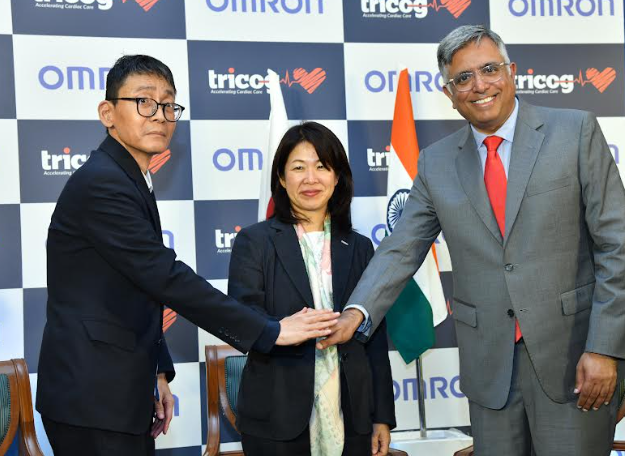
KeeboHealth is a ground-breaking digital health ecosystem that leverages state-of-the-art AI technology, real-time data analytics, and home-based monitoring to empower healthcare providers and patients in managing heart conditions more effectively. The data flows in real-time to Tricog’s AI engine, which continuously monitors heart health, flags early warning signs, and instantly alert medical teams when intervention is needed. This proactive system helps detect heart issues before a patient’s condition detoriates, significantly reducing the need for hospitalizations. The platform integrates seamlessly with OMRON’s range of connected devices-including home ECG monitors, blood pressure monitors, and weighing scales-enabling continuous and personalised care.
OMRON’s ‘Going for Zero’ vision represents its commitment to eliminating heart attacks and strokes through early detection, proactive monitoring, and patient-centric interventions. The integration of KeeboHealth into this vision is a significant milestone, combining Tricog’s cutting-edge AI capabilities and clinical expertise with OMRON’s trusted home health devices and global reach.
Ayumu Okada, Representative Director, President and CEO, OMRON Healthcare Co. Ltd. Commented, “For more than 40 years since we first launched our blood pressure monitor in India in the 1980s, we have been working to solve the health challenges faced by people living in India. In addition to popularizing “home blood pressure measurement,” we have launched innovative devices in India to support early detection of atrial fibrillation, a risky arrhythmia. “KeeboHealth“is a new solution that combines our innovative devices such as “OMRON Complete”, an upper arm blood pressure monitor with ECG, with Tricog’s ECG analysis AI technology. This will connect home and medical care, enabling early detection of deteriorating condition and appropriate intervention. It is also expected to improve the work efficiency of medical professionals. We are confident that this is a big step toward realizing our vision of “Going for Zero.” Through this strategic partnership, we will contribute to enhance the health and well-being of communities throughout India.”
Dr Charit Bhograj, CEO & Founder of Tricog Health, commented, “KeeboHealth is more than technology-it’s hope for millions living with heart failure. By continuously analysing patient data and detecting early warning signs, we can deliver timely, tailored interventions, even in regions where access to specialists is limited. Our collaboration with OMRON ensures we’re not just treating disease but actively preventing the devastating consequences of heart failure. Together, we are moving closer to a world where ‘zero cardiovascular events’ is not just an aspiration but a reality.”
Hokuta Kaya, Deputy Consul General of Japan in Bengaluru, “This ground-breaking partnership between Omron Healthcare and Tricog Health exemplifies the power of combining Japanese technological excellence with Indian ingenuity. Their remote heart monitoring service, which empowers patients to manage their heart health from home using advanced AI and connected devices, is a true game-changer for India’s healthcare landscape. As both our nations work together to bridge the healthcare gap and foster new business opportunities, I am confident that the synergy of Japanese technology and Indian innovation holds immense promise for the future. I hope today’s event inspires many to discover and embrace these pioneering solutions.”
A multinational study involving Duke and UT Southwestern University hospitals in the United States, as well as Manipal Hospital in India, has demonstrated KeeboHealth’s significant impact on heart failure management. Patients demonstrated measurable improvements in exercise capacity and heart health biomarkers by 45%, while adherence to Guideline-Directed Medical Therapy (GDMT) increased to 44%, resulting in a reduction in hospital readmissions. These outcomes underscore how KeeboHealth facilitates early intervention, optimised medication titration, and sustained patient engagement-all critical pillars in reducing cardiovascular events and advancing the “Going for Zero” goal.
OMRON and Tricog plan to expand KeeboHealth widely across India in 2025, marking a paradigm shift in remote cardiac care. The combined expertise of both organisations promises a scalable, cost-effective solution that brings proactive, personalised heart health management to patients worldwide, propelling OMRON’s mission of Going for Zero.
Apollo Launches ‘My Food, My Health’ to Tackle Lifestyle Diseases with Nutrition
Chennai, 10 July 2025: Apollo Hospitals, India’s leading integrated healthcare provider is pleased to announce the release of “My Food, My Health,” an authoritative and comprehensive guide to Medical Nutrition Therapy (MNT). Authored by distinguished dietitians from the Apollo Hospitals Group and curated by Ms. Anita Jatana, Consultant Dietetics at Indraprastha Apollo Hospitals, the book is designed to equip individuals with scientifically validated nutritional guidance, applicable from childhood through advanced age.
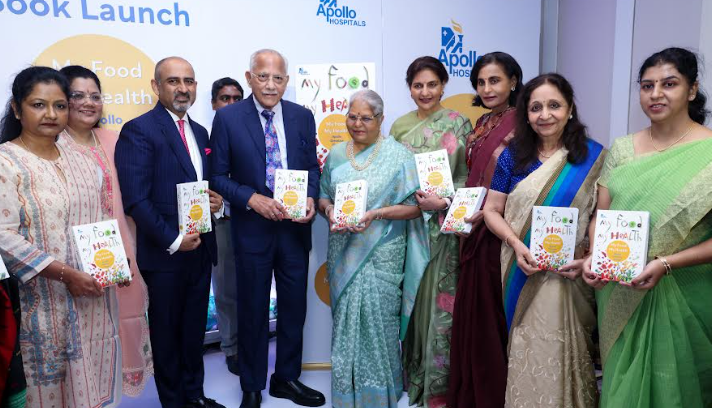
In a time when lifestyle-related illnesses such as diabetes, obesity, cardiovascular diseases, and cancer are on the rise, and misinformation around diet is rampant, “My Food, My Health” serves as a reliable tool to bring clarity and confidence to personal health management.
The book was unveiled by the Chief Guest, Mrs. Sucharitha Reddy, and the first copy was presented to Dr. Prathap C. Reddy, Founder & Chairman of Apollo Hospitals.
Dr. Prathap C. Reddy, Founder & Chairman of Apollo Hospitals, said, “With the launch of ‘My Food, My Health,’ we take another important step toward our goal of making preventive healthcare accessible and practical for everyone. As non-communicable diseases increasingly impact lives across all age groups, we need to educate our communities with the knowledge to make wise choices about their food and health. The choices we make about the food we eat today shape our future. Through this unique compendium of years of experience, we are investing in a stronger, better and happier nation.”
Ms. Anita Jatana, Consultant Dietetics, Indraprastha Apollo Hospitals, said, “In an age where misinformation about nutrition is widespread, ‘My Food, My Health’ seeks to bring clarity and compassion back into how we view food. This book is the result of years of clinical experience and collaboration across Apollo’s network of expert dietitians. It’s designed to help every individual, whether patient, caregiver, or health-conscious reader, make informed, sustainable choices that support lifelong wellness.”
A distinguished group of dietitians and nutritionists across the Apollo Group— Ms. Daphnee DK, Ms. Priyanka Rohatgi, Ms. Haritha Shyam, Ms. Lekha Sreedharan, Ms. Babita G. Hazarika, Ms. Champa Mazumdar, Ms. Varsha Gorey, Ms. Sandhya Singh S., and Ms. Sunita Sahoo—have contributed to this book.
With a reader-friendly format, the book outlines therapeutic dietary strategies and debunks popular myths that cloud public understanding about food and wellness. Aimed at both the general public and healthcare providers, the guide combines clinical insight with actionable advice. The book features simplified dietary guidelines, immune-boosting and stress-management tips, and recovery plans, all paired with easy-to-prepare recipes, nutritional breakdowns, and vibrant photographs.
The launch of ‘My Food, My Health’ marks a significant step in Apollo Hospitals’ ongoing commitment to preventive healthcare and patient education, reinforcing the central role of nutrition in long-term wellness.
Successful Cervical Spine Surgery at Apex Hospitals, Mumbai
10th July, Mumbai: 71-year-old male patient from Malad (Mumbai) underwent a successful posterior cervical laminectomy for multilevel cervical spondylotic myelopathy at Apex Hospital, Borivali which is part of Apex group of Hospitals last week. The surgery marked another important milestone in the hospital’s commitment to advanced spine care. The patient had been experiencing gait instability, weak hand grip, difficulty with fine motor tasks like buttoning his shirt, and radiating pain in both upper limbs—classic symptoms of cervical myelopathy, a condition caused by compression of the spinal cord in the neck due to age-related degenerative changes. If left untreated, this condition can progressively impair mobility and hand function, significantly diminishing quality of life. Following a comprehensive clinical evaluation and imaging, the diagnosis of multilevel cervical myelopathy was confirmed. The surgical team opted for a posterior cervical laminectomy, a procedure designed to relieve pressure on the spinal cord by removing the compressive bony structures. The surgery was performed by Dr. Umang Sheth and Dr. Meet Shah, Spine Surgeons at Apex Hospital, Borivali. The procedure lasted 2 hours and 15 minutes, with minimal blood loss (approx. 100 ml) and no intraoperative complications, ensuring a smooth and safe operative course.
Dr. Umang Sheth Orthopaedic & Spine Surgeon from Apex group of Hospitals stated: “Timely surgical decompression is crucial in patients with cervical myelopathy to halt neurological decline and restore functional independence. Early intervention not only prevents permanent disability but also helps patients regain mobility and confidence. We’re pleased to report that the patient is recovering well, with early improvement in both gait and hand function.”
Dr. Meet Shah, spine consultant from Apex group of Hospitals added: “With precise surgical planning and execution, even complex spinal cases like this can be managed effectively. It’s rewarding to see patients regain functionality and move toward a better quality of life.”
Post-surgery, the patient is undergoing rehabilitation and continues to improve steadily—an outcome that underscores the value of early diagnosis and prompt surgical care in cervical myelopathy.
Apex Hospital, Borivali remains at the forefront of comprehensive spine care, offering cutting-edge techniques and patient-focused treatment to address complex spinal conditions.
With over 25 years of expertise, Apex Group of Hospitals is committed to providing high-quality, accessible healthcare. With more than 350 beds across its Borivali, Kandivali, and Mulund facilities, Apex offers state-of-the-art infrastructure and a patient-first approach to care.
DPU Super Specialty Hospital, Pimpri, Pune Launches One-Stop Centre for Pancreatic Diseases
Pune , 9th July 2025: DPU Super Specialty Hospital, Pimpri, Pune is proud to launch a modern, all-in-one centre dedicated to the diagnosis and treatment of pancreatic diseases. This marks an important step in improving management of pancreatic diseases in India. It continues to lead the way with its focus on innovation and patient-first care. The new centre offers complete and well-coordinated treatment for serious conditions like acute & chronic pancreatitis, pancreatic cancer, and pancreatic cystic lesions.
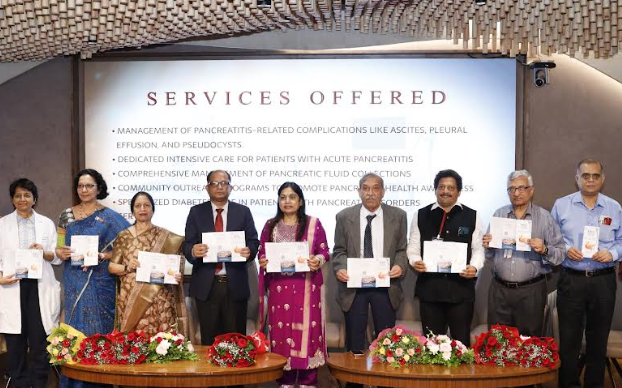
Established under the hospital’s Integrated Centre for Pancreatic Diseases (ICPD), the new unit under the Department of Gastroenterology is designed to deliver early diagnosis, advanced treatment and holistic care for complex conditions such as acute and chronic pancreatitis, pancreatic cancer and pancreatic cysts.
The centre is equipped with cutting-edge diagnostic and therapeutic tools including Endoscopic Ultrasound (EUS), Endoscopic retrograde cholangio-pancreatography (ERCP), Extra-corporeal shockwave lithotripsy (ESWL), as well as high-resolution imaging and precision laboratory testing. What sets this initiative apart, is its fully integrated approach bringing together expert gastroenterologists, pancreatic surgeons, solid organ transplant team, interventional radiologists and endocrinologists to provide coordinated, patient-centric care.
Beyond treatment, the unit will also host specialist consultations, multidisciplinary board meetings to arrive at a consensus to manage complex pancreatic disorders. The team will also conduct educational programs for patients and families, ensuring that every individual receives informed, personalized attention at every step.
With this launch, DPU Super Specialty Hospital, Pimpri, Pune reinforces its commitment to raising the bar in super-specialty care, combining clinical excellence with compassionate service all under one roof.
Hon’ble Dr. (Mrs.) Bhagyashree Patil, Pro Chancellor of Dr. D. Y. Patil Vidyapeeth (Deemed to be University), Pimpri, Pune, said, “The strength of any healthcare institution lies in its ability to offer comprehensive, compassionate and timely care. With this all-in-one advanced centre for pancreatic diseases, we are taking a transformative step forward in early detection, integrated treatment and holistic patient support—all under one roof. This initiative reflects our commitment to delivering world-class healthcare that prioritizes precision, accessibility and patient well-being.”
Hon’ble Dr. Yashraj Patil, Trustee and Treasurer of Dr. D. Y. Patil Vidyapeeth (Deemed to be University), Pimpri, Pune, said, “We are proud to reach this important milestone, which reflects our commitment to cutting-edge healthcare and social responsibility. Pancreatic issues, particularly common in men as they age, require timely and coordinated care. With this advanced centre, we can offer seamless treatment under one roof for patients of all age groups. Our mission remains rooted in compassion and delivering the best care possible.”
Dr Debabrata Banerjee, Head of Department of Medical Gastroenterology at DPU Super Specialty Hospital, Pimpri, Pune said, “We are happy to offer this advanced centre for pancreatic care, which is especially helpful for people coming from far-off places. With all services under one roof, we make it easier to detect issues early, provide the right treatment and offer complete support. We are committed to delivering quality healthcare that is accessible and focused on the well-being of every patient.”
Guttify in Advanced Talks to Raise INR 20 Crore to Accelerate Gut Health Innovation in India
New Delhi, July 8th, 2025 — Guttify, a premium gut health startup by Lifechart, has announced that the company is currently in advanced discussions with leading venture capital firms to raise INR 20 crore in its upcoming funding round.
The company is known for its “Diagnosis-First” approach to solving gut health issues from the core and has already gained early momentum in the wellness and consumer healthcare segments. Sources reveal that 60% of the round is expected to be closed with a well-known VC firm specialising in healthcare and consumer investments.
Adding to its credibility, Guttify recently onboarded Prashant Pitti (Founder, EaseMyTrip & Optimio) as a strategic advisor and investor. Backed by UNICHEM Laboratories’ family office and existing investors. The brand has recently raised $360,000 in extended seed funding in May 2025, taking its current total funding to over $1 million. The funds will be used for the expansion of its diagnosis-first, at-home gut wellness solutions across urban and semi-urban India.
“Our mission has always been to help people solve chronic gut health issues from the core using the power of science and diagnostics. The new funding will be used to scale product development, expand distribution, and invest in research to further enhance personalized gut care solutions,” said Mukul Shah, co-founder at Guttify.
As part of its next innovation cycle, Guttify is gearing up to launch India’s first-of-its-kind RNA gene-based DIY gut testing kits, designed to offer results within 24 hours. This affordable, at-home solution aims to democratise gut health testing and empower individuals to better understand and manage their digestive health without the need for invasive procedures or clinic visits.
How Voll Sante is Fighting India’s Chronic Illness Epidemic with Plant Oils
India today is facing a silent but widespread health crisis. Despite the advancement of modern medicine, chronic illnesses linked to poor diet and nutrition are rising fast. More Indians are catching these diseases at a much younger age now – with 50 percent of heart attacks in Indian men occurring before the age of 50. Nearly one in five deaths in the country is tied to diet-related factors. And while food availability has improved, many people remain overfed yet undernourished, lacking the essential micronutrients needed to sustain long-term health.
The signs are everywhere. Persistent fatigue and low energy have become part of daily life for millions – with over 80% of Indians waking up tired, and a majority of urban youth reporting chronic exhaustion. At the same time, lifestyle-linked risks are surging. Nearly 70% of India’s urban population is overweight, and about 30% of adults show signs of metabolic syndrome, a cluster of conditions that drastically increase the risk of heart disease, stroke, and diabetes. Meanwhile, the lifetime risk of cancer is climbing too, with one in nine Indians likely to be affected.
Underlying all this is a deeper issue that conventional healthcare often overlooks: chronic inflammation, oxidative stress, and widespread nutritional imbalances – not just symptoms, but root causes of modern disease. Addressing these factors calls for more than short-term treatment. It requires a shift toward long-term, preventive care. This is where the idea of “Food as Medicine” is gaining real momentum – and with it, one of the most promising tools in natural healthcare: plant-based functional oils.
These oils are rich in phytonutrients – naturally occurring bioactive compounds found in seeds, herbs, and spices. Unlike synthetic drugs that typically act on a single pathway, phytonutrients are pleiotropic – they work across multiple biological systems simultaneously. Research shows they help regulate inflammation, support mitochondrial function, repair DNA, strengthen immunity, and even aid in hormonal and metabolic balance. In other words, they don’t just suppress symptoms. They help the body restore itself at a deeper level.
But for these benefits to take effect, how they’re delivered matters. Many nutrients lose their potency through poor absorption or degradation. Plant oils offer a superior delivery system – they improve the absorption of fat-soluble compounds, shield sensitive bioactives from oxidation and moisture, and allow for sustained, targeted release within the body. This makes them not only potent but efficient and reliable carriers of nutrition, ideal for ongoing preventive care.
One company working to bring this science into everyday health solutions is Voll Sante Functional Foods & Nutraceuticals, founded in 2017 by Prof. Satya Dev Tiwari. After two decades in the pharmaceutical industry and a stint in academia at NMIMS, Satya became a firm believer in nutritional medicine. He saw the limitations of drug-based approaches to chronic illness and committed instead to developing natural, plant-based interventions that address root causes rather than just symptoms.
Voll Sante’s range of functional oil-filled HPMC capsules is an example of this vision in action. Instead of relying on conventional gelatin capsules – often derived from animal collagen and laced with preservatives, plasticizers, and endocrine-disrupting chemicals – Voll Sante uses a cleaner, safer alternative: plant-based hydroxypropyl methylcellulose (HPMC). These vegetarian capsules are free from plasticizers, preservatives, allergens, starch, and gluten, and are suitable for those following vegetarian or vegan lifestyles.
What goes into the capsules is equally deliberate. While most supplements are made from powdered leaves or extracts, this format often results in lower concentration of bioactives, inconsistent dosing, and poor absorption – especially for fat-soluble compounds. Powders are also more prone to degradation from moisture, air, and light, and typically require synthetic excipients or binders to aid in controlled release.
In contrast, Voll Sante has formulated its supplements using plant-based functional oils – a medium that not only provides higher bioactive density, but also protects delicate compounds from oxidation and environmental damage. Oils enable better absorption of fat-soluble nutrients and ensure a slower, more targeted release in the body. This translates into more consistent, bioavailable dosing – a key advantage when dealing with chronic health conditions that require long-term, systemic support.
Each of their capsules contain a powerful blend of oils such as Black seed, Pumpkin seed, Moringa, Fenugreek, Turmeric, Ginger, Garlic, and Hing – each known for its unique therapeutic properties. These oils are rich in phytonutrients like flavonoids, phytosterols, and saponins that work across multiple systems, helping to regulate inflammation, support hormonal balance, boost immunity, and reduce oxidative stress. They also play a role in improving heart health, joint mobility, digestion, skin health, and cognitive function, making the formulation both broad-spectrum and targeted.
Among these, Black seed oil, in particular, has shown promising clinical outcomes. A 2021 study involving participants with high blood pressure found that those taking black seed oil twice daily for eight weeks saw significant improvements in blood pressure, lipid profile, blood sugar, and oxidative stress markers – all closely linked to metabolic syndrome. The same study also observed an increase in HDL (good cholesterol) and Glutathione Reductase, an important antioxidant enzyme. These results support the use of black seed oil not just as a supplement, but as a valuable adjunct to conventional treatment for lifestyle-related disorders.
As India faces the twin burdens of rising chronic illness and unsustainable healthcare costs, Voll Sante is offering an alternative – one that’s grounded in nature, supported by science, and designed for everyday use. Through its functional oil capsules, the brand is making plant-based nutrition not just acceptable, but essential.
Experts Push for Timely Stroke Rehab and PMR Integration
New Delhi, July 7, 2025: On the occasion of PMR Day, leading neurologists and rehabilitation experts in Delhi are urging urgent integration of Physical Medicine and Rehabilitation (PMR) into India’s stroke care protocols. With stroke now the second leading cause of death and third leading cause of disability in the country, doctors stress that rehabilitation within the first 90 days is essential—not just for survival, but for full functional recovery.
“Stroke is a race against time—not just during the attack, but long after hospital discharge,” said Dr. (Prof.) Man Mohan Mehndiratta, Principal-Director and Senior Consultant, Neurology, BLK-Max Centre for Neurosciences. “While emergency response has improved through ACT FAST awareness, post-stroke recovery remains poorly structured. Without targeted rehabilitation, patients may survive—but lose their independence, speech, or memory.”
Stroke is increasingly affecting younger people in urban centres like Delhi, fueled by rising rates of hypertension, chronic stress, and sedentary lifestyles. According to the India Hypertension Control Initiative (ICMR-WHO, 2023), one in four Indian adults is hypertensive, yet only 12% have it under control.
Experts are now calling for broader adoption of PMR, a multidisciplinary medical specialty that supports recovery after stroke, spinal cord injuries, and head trauma. PMR combines robotic-assisted therapy, speech and occupational therapy, cognitive retraining, and psychological support, all under a structured, evidence-based roadmap led by rehabilitation physicians.
“Rehabilitation is not just exercise—it’s a guided, clinical process,” said Dr. Amit Tomar, Lead Consultant – PMR, HCAH. “The brain’s plasticity is highest in the first three months post-stroke. Every day of delay narrows the window for recovery.”
HCAH (HealthCare atHOME) has built India’s most advanced post-acute neuro-rehabilitation network, with seven specialised PMR centres across Delhi NCR, Mumbai, Bengaluru, Hyderabad, and Kolkata. These centres offer India’s fastest recovery outcomes, combining specialist-led care with cutting-edge technology.
“These numbers reinforce the importance of timely, specialist-led rehab,” said Dr. Gaurav Thukral, Co-founder and Chief Operating Officer, HCAH. “We’ve built a national network of PMR-led neuro-rehab centres that combine clinical expertise with robotic gait therapy, gamified recovery tools, and daily milestone tracking. HCAH is among the only organisations in India delivering recovery this fast, this consistently.”
In a recent HCAH survey, only 40% of respondents could identify stroke symptoms before hospitalisation. Yet among patients who received structured inpatient rehabilitation, 92% regained core functional abilities within three months. In contrast, 70% of those on unstructured home care took over four months to regain basic functions like speech and mobility.
Patient stories underscore these outcomes. A 69-year-old woman in Delhi, left minimally conscious after a major stroke, recovered mobility and speech after three months of structured PMR care. A 19-year-old student with locked-in syndrome regained facial movement and communication through HCAH’s neuro-rehabilitation program.
As stroke cases rise, experts are calling on national and state health authorities to take bold action:
• Embed PMR into every stroke treatment protocol
• Expand insurance coverage for inpatient rehab
• Train more PMR specialists and rehab teams
• Establish dedicated neuro-rehabilitation centres in both public and private healthcare systems
“Rehabilitation is not optional—it’s essential,” said Dr. Mehndiratta. “Survival should not be the end goal. Recovery with dignity must become the new standard.”
